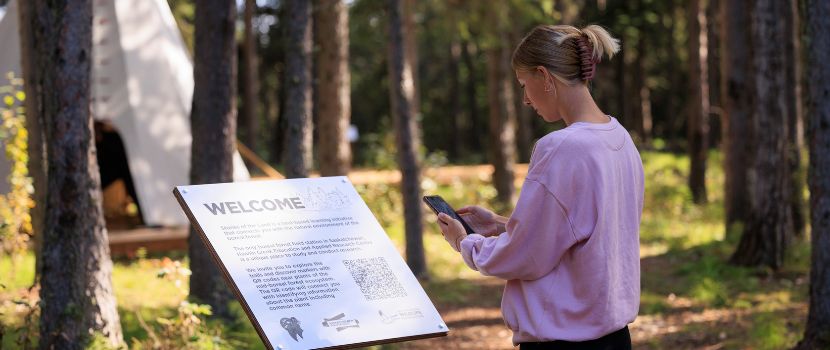PRINCE ALBERT — Students in natural resource programs at Saskatchewan Polytechnic will have a chance to connect to nature through a new land-based knowledge initiative. Stories of the Land is an that showcases plants in the boreal forest, blending technology with Indigenous ways of knowing. Nestled in the , a clearing with tipis surrounded by trees and wilderness, signage introduces the project.
Signs can be found throughout the , from beside the trembling aspen, to the side of the road and across a small bridge. As the fragrance of spruce wafts through the air and squirrels chatter to prepare for the winter ahead, participants in training at the HCEARC look for plants by the signs and scan QR codes to go to an . The webpage shares botanical information, the Cree names of plants and Indigenous ways of knowing such as their medicinal and nutritional use.
Scott Lipsit, academic chair of the , explains the Prince Albert Grand Council (PAGC) collaborated with Sask Polytech on the creation of the encampment and the outdoor Indigenous learning area at Hannin Creek.
“Part of our strategic plan is related to engagement. We want to take steps in reconciliation and engage with Indigenous communities. One of our core objectives at Hannin Creek is education and this project shares Indigenous ways of knowing. There was a strong collaboration with the Indigenous community,” he says.
Edward Mirasty, director of education at the PAGC and Vincent Brittain, third level specialist at the PAGC, travelled to the education centre to share their input.
“Sask Polytech staff wanted to know how to decolonize and reconciliate. When we went to Hannin Creek, we recommended how they could do the layout for students and faculty,” shares Brittain noting they held a Truth and Reconciliation event for students on site. “We want students to understand the impact of intergenerational trauma. The encampment at Hannin Creek creates an opportunity to have these conversations on the impact of past colonial government policies.”
During initial visits in the planning stage, Elders shared stories about plants in the boreal forest. These discussions led to the creation of Stories of the Land.
“We did a walkabout of the facility and were talking about Indigenous plants out there. It was about enlightening people on their usage,” Brittain notes. “In order to create awareness, policies have to change and training needs to take place. We are currently looking at recognizing how institutions do things, and one of the elements is looking into how they are creating space for the future leaders of society.”
Botanist and Sask Polytech instructor, Joanne Marchand found and identified 25 plants. Her list was sent to a Knowledge Keeper to review, who whittled it down to 11 to start the project. Funding came through Sask Polytech’s Academic Innovation Fund.
“This project is innovative in that it brings learners back to the land. It’s walking curriculum. We have outdoor education, but this project adds a technological aspect to learning outside,” says Lipsit.
Teal Fisher, program head of the and programs, started working on the project in the fall of 2023. He oversaw the integration on site, helping with building and installing signage for the project.
“This project will be incorporated into first-year curriculum. It rolls into the students’ plant identification course. Stories of the Land offers students Indigenous awareness in what the plants are traditionally used for. I learned a lot while helping with the project,” he says.
A project like this allows future park interpreters, forestry technicians and conservation officers to gain insight and inspiration into how signage can be used to teach information. Notes Mirasty, “Hannin Creek allows for discovery. Stories of the Land are stories of the people of the land. The QR codes educate people in understanding that the medicines are still С����Ƶ used by our people today.”
The project will follow the course of nature, as signs will be moved if the plants grow in a different area next spring, notes Fisher. Since HCEARC is a research facility, Stories of the Land will be used by students and visiting groups.
The welcomes students and researchers for training on the field, in the boreal forest on the shores of Candle Lake north of Prince Albert, Saskatchewan in Treaty 6 Territory and homeland of the Métis. The education centre is an equal partnership between Sask Polytech and the Saskatchewan Wildlife Federation.




